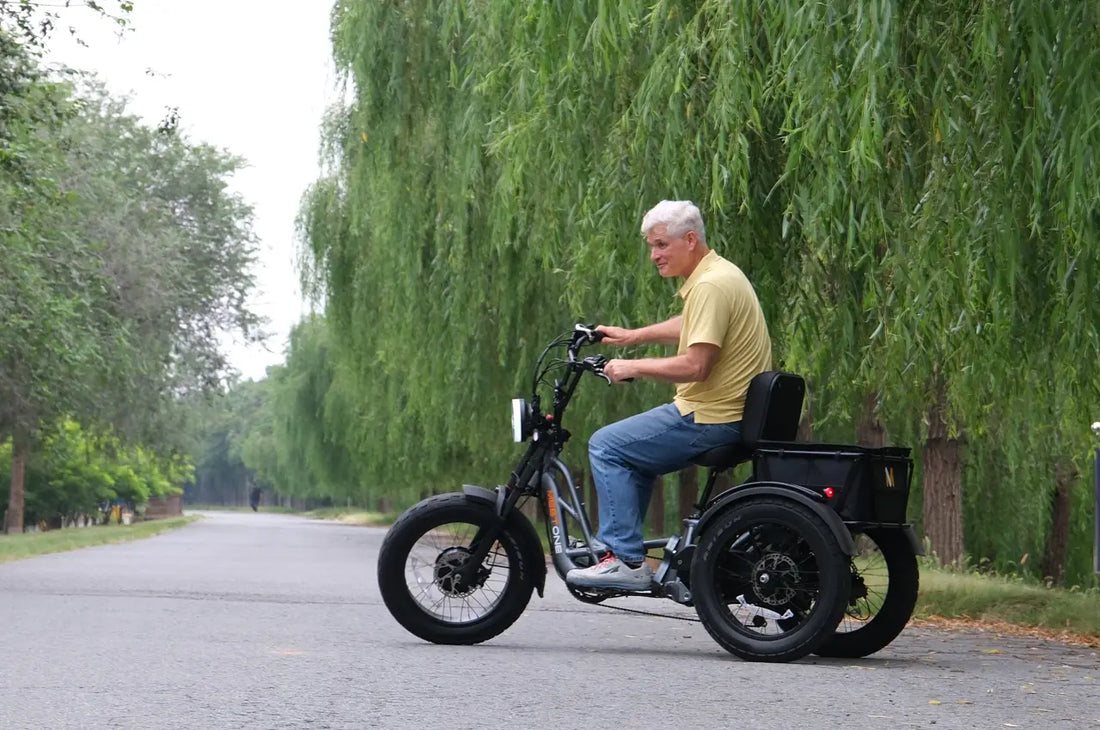
How to Ride an Electric Trike
Riding an electric tricycle offers a unique blend of stability, convenience, and electric-assisted power. However, unlike a traditional two-wheeled bicycle, riding a trike requires adjusting to different control and balance techniques. Today, we’ll guide you through essential tips and steps to help you feel confident and safe when riding an electric trike.
Adjusting Your Steering Technique
Rethinking Balance and Steering
Switching from a standard bicycle to a trike brings a new kind of riding experience—especially when it comes to steering. While cyclists use a mix of handlebar turns and body lean to change direction, trikes depend almost entirely on handlebar steering. Leaning your body, as you would on a bike, can actually cause the trike to drift or feel unstable.
To get comfortable with this, practise the feeling of stationary balance while seated. Here’s a simple step-by-step:
Secure Your Position: Start by placing the trike on flat ground, and engage the parking brake to prevent rolling. Sit comfortably, allowing your body to settle into the trike’s frame.
Grip the Handlebars Firmly: Hold both handlebars with a steady but relaxed grip. This connection is essential, as all directional input comes through your hands—not your weight.
Lean Side to Side: Gently shift your upper body to the left, then return to centre. Repeat on the right. You’ll notice the trike remains stable and upright—this is key. Unlike a bike, the trike supports your balance through its design.
Visualise Steering Without Leaning: Picture turning the handlebars left or right while keeping your upper body still and centred. This reinforces that balance and direction are independent of body lean on a trike.
Electric Trike Power Controls and Safety Tips
Starting with Safety in Mind
Riding an electric trike is simple, but taking a few safety measures ensures a smooth start. Always begin with the motor switched off—this avoids any sudden movement while mounting or adjusting your position. Follow these steps to safely activate the power:
Set Power to Neutral or Zero: Many e-trikes feature a “zero” or “neutral” setting. Confirm it’s selected before switching the motor on. This lets you settle in before engaging any assistance.
Position Your Pedals for a Smooth Start: Adjust the pedals so your dominant foot is forward. This helps with control when you begin pedalling or engage assistance, especially in pedal-assist mode.
Activate the Motor and Select Low Assistance: Once seated and secure, turn on the motor and select the lowest pedal-assist level (usually level one). This provides a gentle boost—ideal for beginners easing into powered riding.
If your trike features both pedal-assist and throttle, here’s how to use them:
- Pedal-Assist: Begin at a low setting like level one for a light boost. As you gain confidence, you can increase it gradually for more support.
- Throttle: This allows you to ride without pedalling by engaging the motor directly. Start with gentle pressure to avoid sudden acceleration. Throttle use is great for hills or quick starts but requires practice, especially in corners or tight spaces.
Navigating Turns Smoothly
Decelerate Into Turns, Accelerate Out
Cornering on a trike differs from turning on a bike. You don’t lean to maintain balance—instead, you stay centred to maintain stability. Here’s how to take turns confidently:
Slow Down Before the Turn: Ease off the throttle or lower the assist level before entering a turn. Slowing down first helps keep your weight balanced across all three wheels.
Stay Centred with Gentle Shifts: While turning, remain aligned with the seat and handlebars. If needed, make a minor shift toward the inside of the turn—but avoid leaning dramatically. This maintains your centre of gravity and improves control.
Accelerate Smoothly Out of the Turn: Once you’re riding straight again, gently increase pedal-assist or throttle. Regaining speed gradually reduces pressure on the rear wheels, helping avoid any tipping.
Practise Wide Turns First: If you’re new to trike riding, start with wide, easy turns in an open area. This builds comfort with decelerating into a turn and accelerating out of it.
Build Muscle Memory Over Time: With regular riding, cornering will feel natural. You’ll learn how much speed to shed and when to reapply power—essential for confidently navigating tighter spaces.
Stopping Safely and Motor Management
Using Brakes and Managing Pedal Assist
To stop smoothly, apply the rear brake first, then the front brake. This method reduces forward lurching and helps with stability.
If you’re using full throttle, release it before turning or slowing down. This allows for a controlled ride and smoother transitions between acceleration and braking. Practise easing in and out of throttle and pedal-assist to avoid sudden surges or stops.
Final Thoughts
Riding an electric trike can be both fun and practical, offering stability and ease on longer journeys. Take your time to adjust, focus on smooth turning, and always be mindful of your speed. With a bit of practice, riding your trike will become second nature.
Enjoy the ride—and stay safe out there!




















